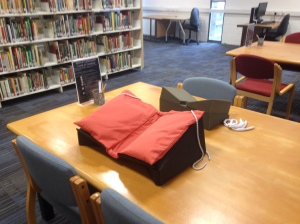A major part of our work in Special Collections is to ensure that our materials will still be available to future generations of scholars and visitors. Many of the objects we hold are made of sturdy stuff, our rare 18th century books will probably outlast us all, but other items such as our photographic collections are more fragile, and even stable materials can become vulnerable over decades. To this end we spend a lot of time making sure materials are stored in optimal conditions to extend their life and usefulness. This week we are participating in the ALA Preservation Week by celebrating all things preservation and giving you an insight into the activities we undertake. You might even pick up a few tips on how to preserve your own special items!

Blue blinds and ultraviolet filters
Where and how you store different materials can have a big impact on their lifespan. We try to store collections in a space that has a consistent temperature and humidity all year round. This is because extremes of temperature and the presence of moisture in the air can induce a harmful reaction in different materials. For instance, paper can be vulnerable to mould in hot and wet conditions or older colour photographs can decay in high temperatures.
This year we have installed some rather snazzy blue blinds to prevent sunlight artificially warming our facility, with the addition of ultraviolet filters to prevent yellowing of paper and fading of inks. We also monitor the temperature and humidity of our collections with some basic digital indicators to give us a warning of problems.

Digital temperature and humidity monitors
Additionally, we keep our eyes peeled for any pests such as silverfish that might take a fancy to our materials for food or accommodation. We use pest traps to monitor any nuisance visitors, and if we find any try to modify the environment to discourage their visits.
Other environmental factors should also be considered. This might include dust, or pollution if you live in a built up area. One way to mitigate these is to store

Pest trap
materials in an enclosure like a box that will prevent light and particles from accessing the item. This is a simple way to preserve heirlooms or keepsakes, although you do have to check on them occasionally to make sure there is nothing happening inside the box itself.
Interestingly, a common way materials become damaged is just through poor handling. To try and minimise handling and stress we use book supports to cradle our printed materials when they are being viewed. We also add a protective layer of Melinex to items like photographs or paper to prevent them from being damaged by constant use. At home, something as simple as washing your hands before handling rare materials can limit environmental pollutants.

Book rests to support texts
With these safeguards in place we hope our collections will be available for years to come.If you would like more information about Preservation week visit the ALA webpages for advice and insights.

















